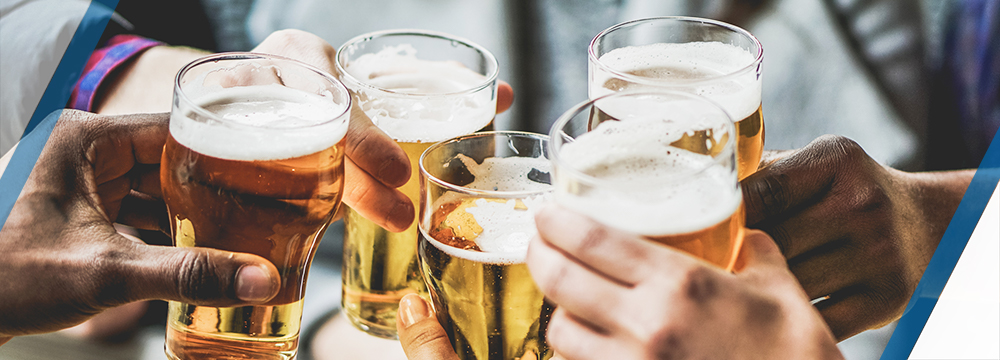Pint of IP: Protecting your Products with Patents
July 29, 2021 – Articles
Since President George Washington signed the first Patent Act of the U.S. Congress into law in 1790, inventors have filed applications and been issued patents directed to beer, wine, and spirits. From Louis Pasteur’s patent titled “IMPROVEMENT IN BREWING BEER AND ALE”[1] to an “ALCOHOL-STILL” patent[2] inspired by Aenas Coffee’s continuous column process to a patent directed to design for a wine or liquid bottle,[3] inventors have utilized patents to protect their alcohol products. With a better understanding of patents, today’s brewers, winemakers, and distillers may take a cue from past inventors and integrate patents into their business strategies to better protect their products and get a competitive advantage against others in the industry.
What is a Patent?
In short, a patent is a property right to exclude others from practicing your invention. The Patent Act defines a patent as “[a]ny new and useful process, machine, manufacture, or composition of matter, or any new and useful improvement thereof,”[4] which basically means, where you have created something new, novel, and non-obvious, it may be patentable. Examples of inventions in the beer, wine, and spirits industry that may be patentable include a process for making beer or a unique liquor bottle design.
There are a few types of patents, but the two that generally apply to brewers are what we call “utility” and “design.” Utility patents are what you typically think of when it comes to patents, in that they protect the functional invention, e.g. the process for making beer, and last for 20 years from the filing date. Design patents protect the way something looks, like the distinctive beer bottle, and have a term of 15 years from the grant date. Utility patents are generally more expensive and have a longer application pendency than design patents.
Why Would A Brewer Care About Patents?
The truth is that the vast majority do not. However, that does not mean they should not and they may be missing out on a key competitive advantage! Just as the name of a beer is an important part of your business, most breweries have other distinct processes and products that could be open for patent protection. With a patent, a brewer can gain an edge in the market by preventing others from practicing the inventive process or product. In addition to excluding others from using the invention, a brewer may mark a product brewed using a unique process with the patent number as a marketing tool and gain notoriety. Moreover, in collaboration with other breweries, a brewer can sell or license the patent to give others the right to practice and use the invention.
That said, a patent may not be the right fit for you. Patent filings can be expensive and take a long time to get through the registration process. But, if you have something truly unique and highly valuable, it may be worth the investment.
Even if you do not want to explore patent protection, if you are developing new processes, techniques, or inventions related to your brewery, you may want to talk to a patent attorney about whether you may be infringing on something someone else owns. It only takes one claim of an entire patent to leave you liable for infringement and “patent trolls” are always lurking. If you are in the business of developing new and innovative processes and inventions with your brewery, it may be time to have a sit down with a patent attorney.
Is This Something I Can Wait to Do Later?
The short answer is, no. The US is a “first to file” system for patents, which means whoever files first will have priority. Meaning, filing as early as possible is important.
Additionally, a patent owner in the US only has a year from disclosure (e.g. presentation at CBC or in the news) to file an application or it will be barred from doing so. As such, even if you did not have to worry about others beating you to the patent office, if you do not get something on file within the one-year window, you may lose your chance forever.
How Does the Patent Process Work?
In making the decision whether or not to file a patent application, you will want to be aware of what we call “prior art,” which is basically any document, product, image, etc. available to the public before you file your application. The scope of this “prior art” will determine whether you can receive a patent, so it is a good idea to work with your patent attorney to conduct a “prior art search” to determine what is out there and what may prevent you from ultimately obtaining your patent.
The application itself will be carefully crafted to avoid the “prior art” and obtain the largest piece of the pie as possible without overlapping with those that came before you. A patent attorney will draft the patent application, relying on inventor input and using the results of the prior art search as a guide for how big to cut the piece of the pie.
After the patent application is prepared, you will finally file the application with the United States Patent and Trademark Office. The application will then go through what we call “prosecution,” which can take up to years of back and forth with the Examiners at the Patent Office who review your application. Your patent attorney will work closely with you to talk through each stage and all the considerations you should keep in mind at each step.
For specific questions concerning the best way to implement patents into your business strategies, contact your Dinsmore Patent Procurement and Management attorney.

